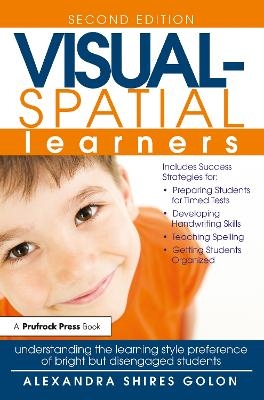
Visual-Spatial Learners
Prufrock Press (Verlag)
978-1-61821-658-8 (ISBN)
Are you looking for ways to differentiate your instruction to meet the needs of gifted visual-spatial learners? You've found it in Visual-Spatial Learners: Understanding the Learning Style Preference of Bright But Disengaged Students (2nd ed.). Visual-spatial learners are students who show advanced abilities with computers, maps, construction toys, and puzzles. The techniques outlined within these pages help all learners succeed—regardless of preferred learning style. Based on the most current understanding of the brain's hemispheric functions, the author provides a number of strategies and lesson plan ideas to help make your classroom a successful learning environment for all learners. These strategies address preparing students to succeed on timed tests; easing the pain of handwriting; teaching spelling using imagery; incorporating mnemonics, rhyme, and other tricks that engage the right hemisphere of the brain; helping students stay focused and on track; getting—and keeping—students organized; and much more!
Alexandra "Allie" Shires Golon is a Master Teacher at Rocky Mountain School for the Gifted and Creative in Boulder, CO. As a teacher and parent of gifted visual-spatial learners, Golon brings a wealth of experience to her books, Raising Topsy-Turvy Kids: Successfully Parenting Your Visual-Spatial Child and If You Could See the Way I Think: A Handbook for Visual-Spatial Kids.
Introduction Chapter 1 Learning Styles Differentiation: Auditory-Sequential and Visual-Spatial Chapter 2 Finding the Visual-Spatial Kids in Your Classroom Chapter 3 Are Boys More Visual-Spatial Than Girls?: Why Gender Matters in Every Classroom Chapter 4 Reading Chapter 5 Creative Writing Chapter 6 The Art of Handwriting Versus the Act of Keyboarding Chapter 7 Helping Students Ace Their Spelling Tests Chapter 8 Taking Notes in Pictures Chapter 9 Teaching Math Facts Chapter 10 Social Studies: A Natural Environment for Strategies Friendly to Visual-Spatial Learners Chapter 11 Using Visual-Spatial Strengths to Learn New Material Chapter 12 Organizational Skills Chapter 13 Helping Your Students Stay Focused Chapter 14 The Dreaded Timed Test Chapter 15 Creating a Visual-Spatial Classroom Additional Resources References About the Author
| Erscheinungsdatum | 14.08.2017 |
|---|---|
| Sprache | englisch |
| Maße | 152 x 229 mm |
| Gewicht | 408 g |
| Themenwelt | Schulbuch / Wörterbuch |
| Geisteswissenschaften ► Psychologie ► Allgemeine Psychologie | |
| Geisteswissenschaften ► Psychologie ► Pädagogische Psychologie | |
| Geisteswissenschaften ► Psychologie ► Verhaltenstherapie | |
| Sozialwissenschaften ► Pädagogik ► Sonder-, Heil- und Förderpädagogik | |
| ISBN-10 | 1-61821-658-9 / 1618216589 |
| ISBN-13 | 978-1-61821-658-8 / 9781618216588 |
| Zustand | Neuware |
| Informationen gemäß Produktsicherheitsverordnung (GPSR) | |
| Haben Sie eine Frage zum Produkt? |
aus dem Bereich


